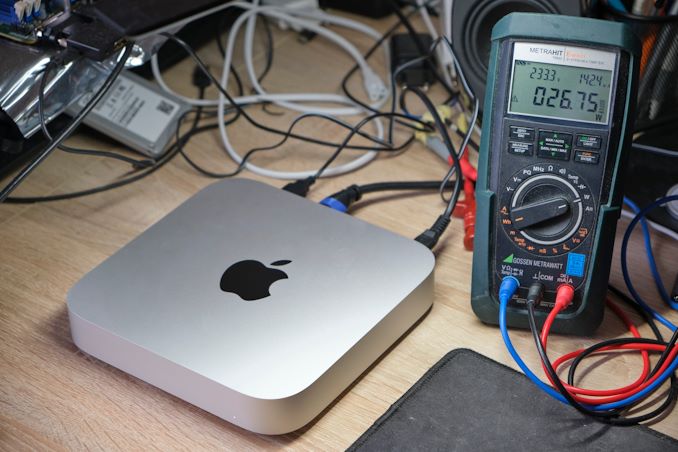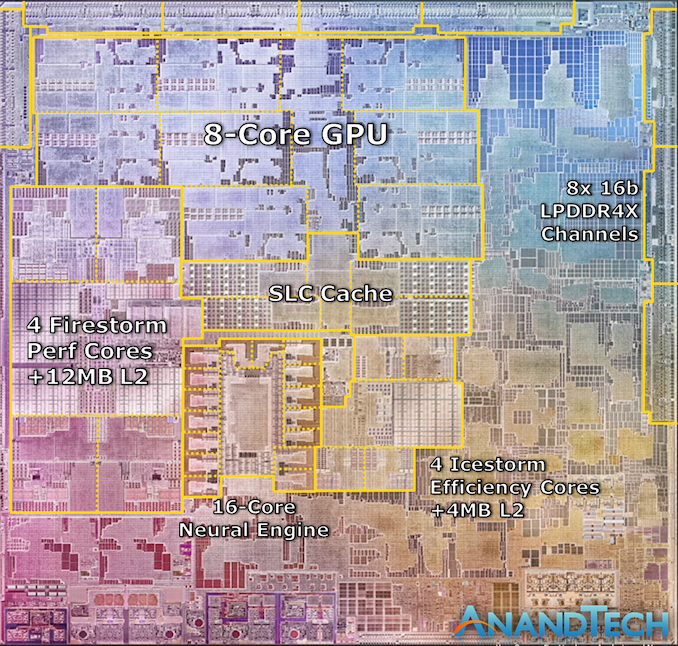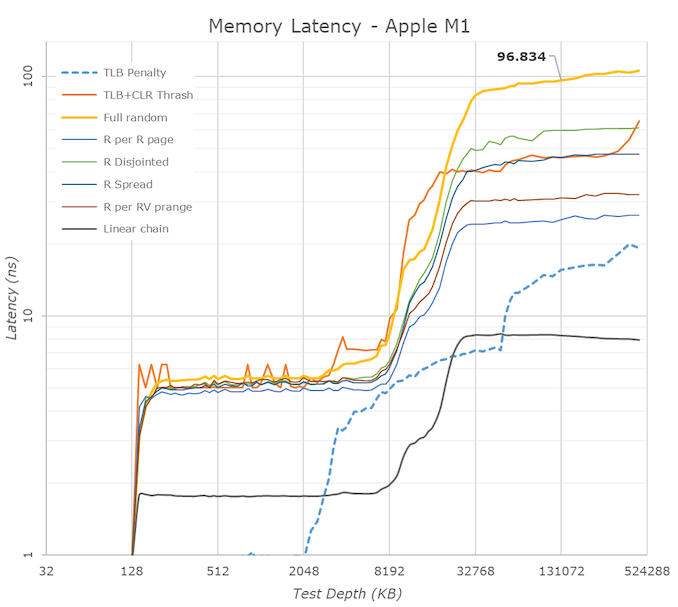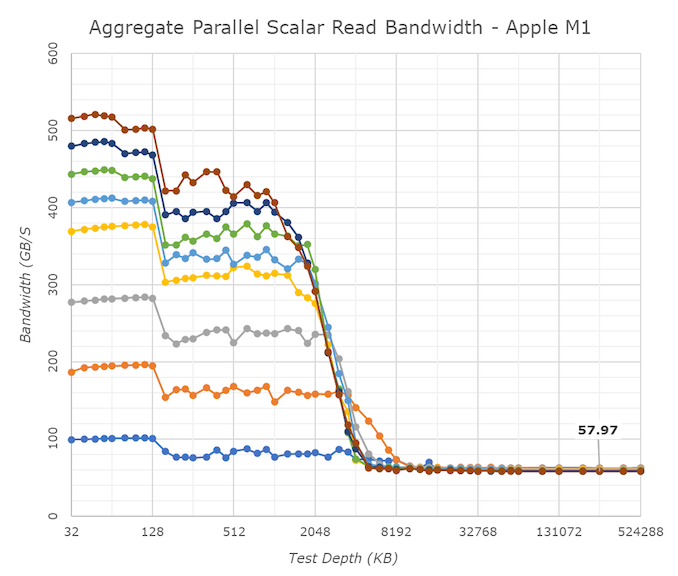The 2020 Mac Mini Unleashed: Putting Apple Silicon M1 To The Test
by Andrei Frumusanu on November 17, 2020 9:00 AM EST
Last week, Apple made industry news by announcing new Mac products based upon the company’s new Apple Silicon M1 SoC chip, marking the first move of a planned 2-year roadmap to transition over from Intel-based x86 CPUs to the company’s own in-house designed microprocessors running on the Arm instruction set.
During the launch we had prepared an extensive article based on the company’s already related Apple A14 chip, found in the new generation iPhone 12 phones. This includes a rather extensive microarchitectural deep-dive into Apple’s new Firestorm cores which power both the A14 as well as the new Apple Silicon M1, I would recommend a read if you haven’t had the opportunity yet:
Since a few days, we’ve been able to get our hands on one of the first Apple Silicon M1 devices: the new Mac mini 2020 edition. While in our analysis article last week we had based our numbers on the A14, this time around we’ve measured the real performance on the actual new higher-power design. We haven’t had much time, but we’ll be bringing you the key datapoints relevant to the new Apple Silicon M1.
Apple Silicon M1: Firestorm cores at 3.2GHz & ~20-24W TDP?
During the launch event, one thing that was in Apple fashion typically missing from the presentation were actual details on the clock frequencies of the design, as well as its TDP which it can sustain at maximum performance.
We can confirm that in single-threaded workloads, Apple’s Firestorm cores now clock in at 3.2GHz, a 6.66% increase over the 3GHz frequency of the Apple A14. As long as there's thermal headroom, this clock also applies to all-core loads, with in addition to 4x 3.2GHz performance cores also seeing 4x Thunder efficiency cores at 2064MHz, also quite a lot higher than 1823MHz on the A14.
Alongside the four performance Firestorm cores, the M1 also includes four Icestorm cores which are aimed for low idle power and increased power efficiency for battery-powered operation. Both the 4 performance cores and 4 efficiency cores can be active in tandem, meaning that this is an 8-core SoC, although performance throughput across all the cores isn’t identical.
The biggest question during the announcement event was the power consumption of these designs. Apple had presented several charts including performance and power axes, however we lacked comparison data as to come to any proper conclusion.
As we had access to the Mac mini rather than a Macbook, it meant that power measurement was rather simple on the device as we can just hook up a meter to the AC input of the device. It’s to be noted with a huge disclaimer that because we are measuring AC wall power here, the power figures aren’t directly comparable to that of battery-powered devices, as the Mac mini’s power supply will incur a efficiency loss greater than that of other mobile SoCs, as well as TDP figures contemporary vendors such as Intel or AMD publish.
It’s especially important to keep in mind that the figure of what we usually recall as TDP in processors is actually only a subset of the figures presented here, as beyond just the SoC we’re also measuring DRAM and voltage regulation overhead, something which is not included in TDP figures nor your typical package power readout on a laptop.

Starting off with an idle Mac mini in its default state while sitting idle when powered on, while connected via HDMI to a 2560p144 monitor, Wi-Fi 6 and a mouse and keyboard, we’re seeing total device power at 4.2W. Given that we’re measuring AC power into the device which can be quite inefficient at low loads, this makes quite a lot of sense and represents an excellent figure.
This idle figure also serves as a baseline for following measurements where we calculate “active power”, meaning our usual methodology of taking total power measured and subtracting the idle power.
During average single-threaded workloads on the 3.2GHz Firestorm cores, such as GCC code compilation, we’re seeing device power go up to 10.5W with active power at around 6.3W. The active power figure is very much in line with what we would expect from a higher-clocked Firestorm core, and is extremely promising for Apple and the M1.
In workloads which are more DRAM heavy and thus incur a larger power penalty on the LPDDR4X-class 128-bit 16GB of DRAM on the Mac mini, we’re seeing active power go up to 10.5W. Already with these figures the new M1 is might impressive and showcases less than a third of the power of a high-end Intel mobile CPU.
In multi-threaded scenarios, power highly depends on the workload. In memory-heavy workloads where the CPU utilisation isn’t as high, we’re seeing 18W active power, going up to around 22W in average workloads, and peaking around 27W in compute heavy workloads. These figures are generally what you’d like to compare to “TDPs” of other platforms, although again to get an apples-to-apples comparison you’d need to further subtract some of the overhead as measured on the Mac mini here – my best guess would be a 20 to 24W range.
Finally, on the part of the GPU, we’re seeing a lower power consumption figure of 17.3W in GFXBench Aztec High. This would contain a larger amount of DRAM power, so the power consumption of Apple’s GPU is definitely extremely low-power, and far less than the peak power that the CPUs can draw.
Memory Differences
Besides the additional cores on the part of the CPUs and GPU, one main performance factor of the M1 that differs from the A14 is the fact that’s it’s running on a 128-bit memory bus rather than the mobile 64-bit bus. Across 8x 16-bit memory channels and at LPDDR4X-4266-class memory, this means the M1 hits a peak of 68.25GB/s memory bandwidth.
In terms of memory latency, we’re seeing a (rather expected) reduction compared to the A14, measuring 96ns at 128MB full random test depth, compared to 102ns on the A14.
Of further note is the 12MB L2 cache of the performance cores, although here it seems that Apple continues to do some partitioning as to how much as single core can use as we’re still seeing some latency uptick after 8MB.
The M1 also contains a large SLC cache which should be accessible by all IP blocks on the chip. We’re not exactly certain, but the test results do behave a lot like on the A14 and thus we assume this is a similar 16MB chunk of cache on the SoC, as some access patterns extend beyond that of the A14, which makes sense given the larger L2.
One aspect we’ve never really had the opportunity to test is exactly how good Apple’s cores are in terms of memory bandwidth. Inside of the M1, the results are ground-breaking: A single Firestorm achieves memory reads up to around 58GB/s, with memory writes coming in at 33-36GB/s. Most importantly, memory copies land in at 60 to 62GB/s depending if you’re using scalar or vector instructions. The fact that a single Firestorm core can almost saturate the memory controllers is astounding and something we’ve never seen in a design before.
Because one core is able to make use of almost the whole memory bandwidth, having multiple cores access things at the same time don’t actually increase the system bandwidth, but actually due to congestion lower the effective achieved aggregate bandwidth. Nevertheless, this 59GB/s peak bandwidth of one core is essentially also the speed at which memory copies happen, no matter the amount of active cores in the system, again, a great feat for Apple.
Beyond the clock speed increase, L2 increase, this memory boost is also very likely to help the M1 differentiate its performance beyond that of the A14, and offer up though competition against the x86 incumbents.
- Page 1: Apple Silicon M1: Recap, Power Consumption
- Page 2: Benchmarks: Whatever Is Available
- Page 3: M1 GPU Performance: Integrated King, Discrete Rival
- Page 4: SPEC2006 & 2017: Industry Standard - ST Performance
- Page 5: SPEC2017 - Multi-Core Performance
- Page 6: Rosetta2: x86-64 Translation Performance
- Page 7: Conclusion & First Impressions













682 Comments
View All Comments
GeoffreyA - Saturday, November 21, 2020 - link
To find truth here, it's important to keep the 5950X out of the picture, and look closely at Renoir and the M1. As others have already pointed out, 15W Renoir is not so far behind in single-threaded performance (which is the building block of everything else). Zen 3 + 5 nm should put them on a roughly equal footing. Give or take. Also, according to the TGL review, I see that 15W Renoir draws about 23W on a multi-threaded load: similar to the M1 as far as I can tell.* And Z3 uses about the same, or even less, power than Z2.This suggests that Apple's and AMD's microarchitectures, according to Cinebench and some of SPEC at any rate, are roughly the same from a performance and power point of view. Great work from Apple, certainly. But hardly a slaughter. Seems these old-fashioned x86 CPUs, while shackled by the variable-length chains, are able to hold up against ARM after all. Who knows, maybe Rosetta 3 will be translating back in a decade's time ;)
* Did see a test, on Notebookcheck, where the 4800U drew about 50W, but that's in Prime95 and likely using a higher than 15W TDP. A review of the Yoga Slim 7 on Ultrabookreview showed a range of TDPs.
GeoffreyA - Wednesday, November 18, 2020 - link
As for the Pentium M and Athlon 64, I am making that statement from memory and need to double-check the actual review: I remember Anand did that test a long time ago, before the Core days, and what I remember (only read it a few years ago) was that the Pentium M was too close for comfort to the K8, even beating it quite a few times.Spunjji - Thursday, November 19, 2020 - link
You're 100% accurate with that recollection. I bought a Pentium M at the time and rolled it into a desktop system because I couldn't afford an Athlon 64. It could run passively under a Zalman Flower cooler with a pin mod that took it from 1.6Ghz to just over 2Ghz, and at that rate it was competitive with (not better than!) some of the best gaming systems out there.This is quite reminiscent of that - a new low power CPU showing up and bloodying the nose of the incumbent heavyweight(s). Only difference is we don't get to build this into our own systems :/
GeoffreyA - Friday, November 20, 2020 - link
Great memory of your Pentium M clocked at 2 GHz. Though I never owned one, I hold this CPU in very high regard, simply because it was such an excellent piece of work (nice intelligent additions on top of the Pentium III's design) and the foundation of Core. Its surprising performance against the "infallible" Athlon 64 was a foreshadowing of things to come.GeoffreyA - Friday, November 20, 2020 - link
As for me, I got an Athlon 64 back then, but it was before the X2 came out, so prices weren't that bad. Wasn't very high-end though: the Socket 754 3000+ clocked at 2 GHz. So I missed out on Socket 939 and dual channel memory. My motherboard was a Chaintech VNF3-250. Unfortunately, it came with a no-name brand 300W PSU, which slowly fried something over time. All in all, could barely boot after just 4 years.Spunjji - Monday, November 23, 2020 - link
The AOpen MoDT board I built my Pentium M system with failed after just under a year - and that was with a very high-quality PSU. The RMA replacement failed again in a similar time-frame. I think a lot of boards from that era just weren't that great!GeoffreyA - Thursday, November 26, 2020 - link
Yes, those old boards were a mess, packed to the brim with components. It's startling to reflect how clean boards have become over the past decade.trboyden - Tuesday, November 17, 2020 - link
Still seems to be a lot of fanboyish behavior when it comes to Apple performance testing. Apple has long been known not to put the best performing Intel CPU in their machines which is why they always suffered performance-wise against performance oriented PCs. Then you have these test results where the tester claims a win for Apple when the M1 can't even beat an Intel 1165G7 processor at 10nm and 4 cores. Geekbench scores have always been suspect, so no one really trusts those. The Cinebench scores are probably the closest to reality, but the testing suffers from a lack of testing against modern Intel 8-core processors such as the i9-10885H which themselves are still only 14nm. I think the Apple ARM chip is definitely going to be competitive, but it is far too early to call it a dominant chip. With Apple turning all of their devices into glorified tablets running mobile apps, it is not exactly the best platform to benchmark the performance of a working class PC.bernstein - Tuesday, November 17, 2020 - link
one should note that performance doesn't scale with power... or rather not linearly. on the other hand having the fastest core that uses less power than competitors mostly negates this, as scaling from a 4-core to 16-core should be easily doable. this would put them at a roughly comparable mc-perf than a ryzen 5950xxenol - Tuesday, November 17, 2020 - link
I'd argue the M1's GPU is a much bigger eyebrow raiser than the CPU. 21W system power consumption (so GPU is probably floating around 12-15W) yet gets within spitting distance of the 1650. Even if we take the laptop version, it's still 35W-50W for just the graphics module. That's nuts.Though one has to wonder how much inefficiencies on the 1650 are due to software inefficiencies.